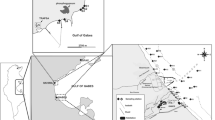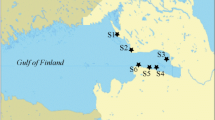Abstract
In Lake Geneva (Switzerland), 14 tubificid and 2 lumbriculid worm species were collected in a total of 170 samples of sediment. The sediment was analysed through ten chemical variables: organic carbon, total phosphorus, Cd, Zn, Sn, Pb, Hg, Cu, Cr, Mn. The chemical environment characterizing the presence of every worm species was defined by the mean value of each of these ten variables in all samples where the species was found. The multivariate comparison of the chemical environment typical of every species enabled six groups of species to be distinguished, each characterized by the high value of one chemical variable: (1) Peloscolex ferox, Potamothrix hammoniensis, Limnodrilus claparedeanus, and Cd. (2) Psammoryctides barbatus, and Zn. (3) Limnodrilus hofmeisteri, L. udekemianus, L. profundicola, and total P. (4) Potamothrix heuscheri, Aulodriluspluriseta, A. limnobius, Tubifex tubifex, Ilyodrilus templetoni, Stylodrilus heringianus, and organic C. (5) Potamothrixvejdovskyi, and, Hg. (6) Peloscolex velutinus, Stylodrilus lemani, and Mn. Pollution level of the sediment decreased from group 1 to 6, so each of these groups may be used to define a different level of pollution. The pooled coefficient of variation of the ten chemical variables used to define the chemical environment of each species diminished from group 1 to 6: the most opportunistic species colonized the most polluted areas.
Similar content being viewed by others
References
Bertier, P. & Bouroche, J. M. 1975. Analyse des données multidimensionnelles. Presses Universitaires de France, Paris.
Brinkhurst, R. O. 1974. The benthos of lakes. The Macmillan Press Ltd, London and Basingstoke.
Brinkhurst, R. O. & Cook, D. G. 1974. Aquatic Earthworm (Annelida: Oligochaeta). In: Hart, Jr. C. W. and Fuller, Samuel L. H. (ed.), Pollution ecology of freshwater invertebrates. Academic Press, New York, pp. 143–156.
Juget, J. 1967. La faune benthique du Léman, modalités et déterminisme écologique du peuplement. Thèse de l'Université de Lyon, 360 pp.
Lagauterie, P. & Leroux, P. 1977. Une méthode d'analyse de la sensibilité aux facteurs ambiants des macro-invertébrés benthiques des eaux courantes. Terre et Vie, 31: 327–342.
Lang, C. 1978a. Factorial correspondence analysis of oligochaeta communities according to eutrophication level. Hydrobiologia 57: 241–247.
Lang, C. 1978b. Approche multivariable de la détection biologique et chimique des pollutions dans le lac Léman (Suisse). Arch. Hydrobiol. 83: 158–178.
Lang, C. & Dobler-Lang, B. 1977. Eutrophisation et pollution du littoral lémanique évaluées à partir de la composition de la faune benthique. Première partie: Les régions avoisinant les stations d'épuration. Rapports de la commission internationale pour la protection des eaux du lac Léman contre la pollution.
Mackereth, F. J. H. 1966. Some chemical observations on postglacial lake sediments. Phil. Trans. R. Soc. B. (Lond.) 250: 165–213.
Milbrink, G. 1973. On the Use of Indicator Communities of Tubificidae and some Lumbriculidae in the Assessment of Water Pollution in Swedish Lakes. Zoon 1: 125–139.
Roback, Selwyn S. 1974. Insects (Arthropoda: Insecta). In: Hart. Jr. C. W. and Fuller, Samuel L. H. (ed). Pollution ecology of freshwater invertebrates. Academic Press, New York, pp. 313–376.
Vernet, J. P., Scolari, G. & Jacquet, J. M. 1976. Etude de la pollution des séediments du Léman et du bassin du Rhône. Partie B: pollution des zones côtières du Léman par les métaux lourds. Rapports de la commission internationale pour la protection des eaux du lac Léman contre la pollution, pp. 283–311.
Author information
Authors and Affiliations
Rights and permissions
About this article
Cite this article
Lang, C., Lang-Dobler, B. The chemical environment of tubificid and lumbriculid worms according to the pollution level of the sediment. Hydrobiologia 65, 273–282 (1979). https://doi.org/10.1007/BF00038868
Received:
Issue Date:
DOI: https://doi.org/10.1007/BF00038868




